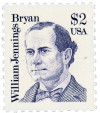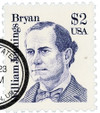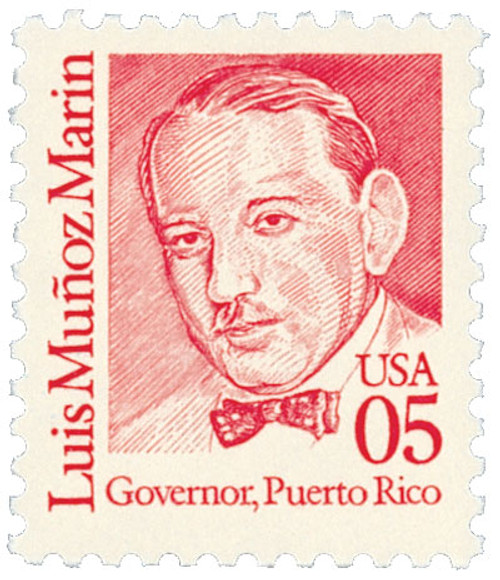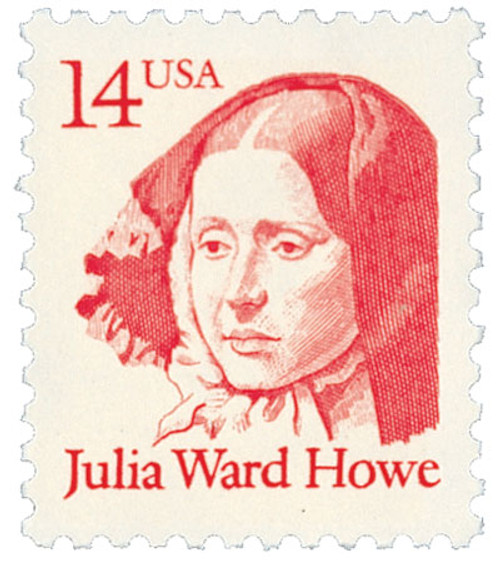
# 2195 - 1986 $2 Great Americans: William Jennings Bryan
U.S. #2195
1986 $2 William Jennings Bryan
Great Americans
- Issued on Bryan’s 126th birthday
- Longest name in the series; needed to wrap around two sides of stamp
Stamp Category: Definitive
Series: Great Americans
Value: $2, covered the make-up postage on heavy postal items
First Day of Issue: March 19, 1986
First Day City: Salem, Illinois
Quantity Issued: 57,250,000
Printed by: Bureau of Engraving and Printing
Printing Method: Engraved
Format: Panes of 100 in sheets of 800
Perforations: 11
Color: Bright violet
Why the stamp was issued: This stamp covered the make-up postage on heavy postal items. And while it didn’t pay a specific rate, it was one of the stamps needed most urgently in early 1986. The Bureau of Engraving and Printing had released all existing stockpiles of the 1978 $2 Kerosene Lamp stamp, and didn’t want to print a small number when the Bryan stamp was slated for release in March. In the meantime, post offices and mailers had to get creative, combining other stamps to meet the postage.
About the stamp design: This was the first stamp design for Tom Broad. He based his artwork on a photo approved by the Citizens’ Stamp Advisory Committee. No modeler was needed, as the plates were engraved directly from his drawing.
Special design details: William Jennings Bryan had the longest name of anyone in the Great Americans Series. The USPS didn’t want to omit his middle name, as his full name was so well known. It would be too small to try to fit all three words on one side of the stamp, so it wrapped around the upper left corner, with his last name on the top of the stamp.
First Day City: The First Day ceremony for this stamp was held at Franklin Park Elementary School in Salem, Illinois, Bryan’s hometown.
Unusual fact about this stamp: Varieties of this stamp have been found with “worn tagging mats on which horizontal untagged areas have taggant giving the appearance of vertical band tagging” according to Scott Specialized Catalogue of United States Stamps.
About the Great Americans Series: The Great Americans Series was created to replace the Americana Series. The new series would be characterized by a standard definitive size, simple design, and monochromatic colors.
This simple design included a portrait, “USA,” the denomination, the person’s name, and in some cases, their occupation or reason for recognition. The first stamp in the new series was issued on December 27, 1980. It honored Sequoyah and fulfilled the new international postcard rate that would go into effect in January 1981.
The Great Americans Series would honor a wider range of people than the previous Prominent Americans and Liberty Series. While those series mainly honored presidents and politicians, the Great Americans Series featured people from many fields and ethnicities. They were individuals who were leaders in education, the military, literature, the arts, and human and civil rights. Plus, while the previous series only honored a few women, the Great Americans featured 15 women. This was also the first definitive series to honor Native Americans, with five stamps.
The Bureau of Engraving and Printing (BEP) produced most of the stamps, but private firms printed some. Several stamps saw multiple printings. The result was many different varieties, with tagging being the key to understanding them. Though there were also differences in perforations, gum, paper, and ink color.
The final stamp in the series was issued on July 17, 1999, honoring Justin S. Morrill. Spanning 20 years, the Great Americans was the longest-running US definitive series. It was also the largest series of face-different stamps, with a total of 63.
Click here for all the individual stamps and click here for the complete series.
History the stamp represents: William Jennings Bryan was born on March 19, 1860, in Salem, Illinois. Known as “The Great Commoner,” Jennings ran for president three times, but is remembered for his impassioned speeches on a variety of topics, including anti-trust, anti-imperialism, prohibition, populism, and trust-busting.
The fourth of nine children, Bryan was home schooled by his mother until he was 10 years old. He enjoyed public speaking, giving his first speech when he was just four. Bryan attended Illinois College, where he participated in many debates and speaking contests. He graduated at the top of his class in 1881 and went on to earn a Bachelor of Laws from Chicago’s Union Law College (present-day Northwestern University School of Law).
In 1887, Bryan established a law practice in Lincoln, Nebraska and began participating in politics. Delivering stirring campaign speeches for others, he was encouraged to run for Congress in 1890. He won that seat with promises to reduce tariffs and the power of trusts and adjust the value of silver coinage compared to gold. Bryan was appointed to the House Ways and Means Committee and won reelection in 1892. Though he was unable to save the Sherman Silver Purchase Act following the Panic of 1893, Bryan got an amendment passed that created the first peacetime federal income tax.
In 1894, Bryan failed to win election to the Senate. He then spent his time touring the country giving speeches to gain support for his causes, including free silver, and raising his national profile before the next election. At the 1896 Democratic National Convention, Bryan delivered his stirring “Cross of Gold” speech in support of free silver over the gold standard. By the fifth ballot, he earned the party’s presidential nomination. Just 36 years old, he was the youngest person to receive a presidential nomination by a major party, a distinction he still holds today.
Banking on Bryan’s speaking abilities, he went on a national tour, giving 600 speeches before about five million people in 27 states. Though he earned solid support from farmers and silver miners, he ultimately lost the election to William McKinley. Bryan remained popular in his party, and after the Spanish-American War broke out, the Nebraska governor tasked him with forming his own regiment. Bryan recruited 2,000 men, but the war ended before they could be sent to Cuba.
In 1900, Bryan unanimously won the Democratic presidential nomination. Anti-imperialism was his primary focus, though he also pushed for free silver and opposing trusts. Bryan campaigned extensively, delivering about 63,000 words a day, between giving four speeches as well as smaller talks. He ultimately lost that election and spent the next few years lecturing. In 1901, he began publishing his own newspaper, The Commoner. Within five years, he had 145,000 subscribers, and it was one of the most popular papers of the time. Bryan then spent three years in Europe and Asia, delivering speeches and recording his thoughts on “The Old World and Its Ways.”
When he returned to the US, Bryan regained support within his party and was selected as the Democratic presidential nominee on the first ballot. However, he lost the 1908 election to William Howard Taft. Bryan is the only major party nominee since the Civil War to lose three US presidential elections, and his combined total of 493 electoral votes is more than any other candidate who was never elected president.
Bryan opted not to run for president in 1912 and instead used his influence in the party to push for Woodrow Wilson’s election. After Wilson was elected, he made Bryan his secretary of State. In that role, Bryan supported the reduction of tariff rates, a progressive income tax, anti-trust legislation, and the creation of the Federal Reserve System. He also worked with 30 countries in a series of bilateral treaties and oversaw US involvement in Haiti, the Dominican Republic, and Mexico. Bryan resigned his post in 1915 following disagreements with the Wilson administration’s response to World War I. After the US entered the war, Bryan offered his services to Wilson, agreeing to show his support through speeches and articles.
In his later years, Bryan spoke out in support of the eight-hour work day, minimum wage, the right of unions to strike, and women’s suffrage, though most of his efforts focused on prohibition and opposition to teaching evolution. Despite being a top contender for the 1920 nomination, Bryan declined to enter the election. He was a driving force behind the Florida real estate boom of the 1920s and served on the Board of Trustees at American University. Bryan represented the World Christian Fundamentals Association during the 1925 Scopes Trial, but died five days after the trial ended on July 26, 1925. Though historians debate his legacy, many recognize he played a major role in shaping public policies for more than 40 years.
U.S. #2195
1986 $2 William Jennings Bryan
Great Americans
- Issued on Bryan’s 126th birthday
- Longest name in the series; needed to wrap around two sides of stamp
Stamp Category: Definitive
Series: Great Americans
Value: $2, covered the make-up postage on heavy postal items
First Day of Issue: March 19, 1986
First Day City: Salem, Illinois
Quantity Issued: 57,250,000
Printed by: Bureau of Engraving and Printing
Printing Method: Engraved
Format: Panes of 100 in sheets of 800
Perforations: 11
Color: Bright violet
Why the stamp was issued: This stamp covered the make-up postage on heavy postal items. And while it didn’t pay a specific rate, it was one of the stamps needed most urgently in early 1986. The Bureau of Engraving and Printing had released all existing stockpiles of the 1978 $2 Kerosene Lamp stamp, and didn’t want to print a small number when the Bryan stamp was slated for release in March. In the meantime, post offices and mailers had to get creative, combining other stamps to meet the postage.
About the stamp design: This was the first stamp design for Tom Broad. He based his artwork on a photo approved by the Citizens’ Stamp Advisory Committee. No modeler was needed, as the plates were engraved directly from his drawing.
Special design details: William Jennings Bryan had the longest name of anyone in the Great Americans Series. The USPS didn’t want to omit his middle name, as his full name was so well known. It would be too small to try to fit all three words on one side of the stamp, so it wrapped around the upper left corner, with his last name on the top of the stamp.
First Day City: The First Day ceremony for this stamp was held at Franklin Park Elementary School in Salem, Illinois, Bryan’s hometown.
Unusual fact about this stamp: Varieties of this stamp have been found with “worn tagging mats on which horizontal untagged areas have taggant giving the appearance of vertical band tagging” according to Scott Specialized Catalogue of United States Stamps.
About the Great Americans Series: The Great Americans Series was created to replace the Americana Series. The new series would be characterized by a standard definitive size, simple design, and monochromatic colors.
This simple design included a portrait, “USA,” the denomination, the person’s name, and in some cases, their occupation or reason for recognition. The first stamp in the new series was issued on December 27, 1980. It honored Sequoyah and fulfilled the new international postcard rate that would go into effect in January 1981.
The Great Americans Series would honor a wider range of people than the previous Prominent Americans and Liberty Series. While those series mainly honored presidents and politicians, the Great Americans Series featured people from many fields and ethnicities. They were individuals who were leaders in education, the military, literature, the arts, and human and civil rights. Plus, while the previous series only honored a few women, the Great Americans featured 15 women. This was also the first definitive series to honor Native Americans, with five stamps.
The Bureau of Engraving and Printing (BEP) produced most of the stamps, but private firms printed some. Several stamps saw multiple printings. The result was many different varieties, with tagging being the key to understanding them. Though there were also differences in perforations, gum, paper, and ink color.
The final stamp in the series was issued on July 17, 1999, honoring Justin S. Morrill. Spanning 20 years, the Great Americans was the longest-running US definitive series. It was also the largest series of face-different stamps, with a total of 63.
Click here for all the individual stamps and click here for the complete series.
History the stamp represents: William Jennings Bryan was born on March 19, 1860, in Salem, Illinois. Known as “The Great Commoner,” Jennings ran for president three times, but is remembered for his impassioned speeches on a variety of topics, including anti-trust, anti-imperialism, prohibition, populism, and trust-busting.
The fourth of nine children, Bryan was home schooled by his mother until he was 10 years old. He enjoyed public speaking, giving his first speech when he was just four. Bryan attended Illinois College, where he participated in many debates and speaking contests. He graduated at the top of his class in 1881 and went on to earn a Bachelor of Laws from Chicago’s Union Law College (present-day Northwestern University School of Law).
In 1887, Bryan established a law practice in Lincoln, Nebraska and began participating in politics. Delivering stirring campaign speeches for others, he was encouraged to run for Congress in 1890. He won that seat with promises to reduce tariffs and the power of trusts and adjust the value of silver coinage compared to gold. Bryan was appointed to the House Ways and Means Committee and won reelection in 1892. Though he was unable to save the Sherman Silver Purchase Act following the Panic of 1893, Bryan got an amendment passed that created the first peacetime federal income tax.
In 1894, Bryan failed to win election to the Senate. He then spent his time touring the country giving speeches to gain support for his causes, including free silver, and raising his national profile before the next election. At the 1896 Democratic National Convention, Bryan delivered his stirring “Cross of Gold” speech in support of free silver over the gold standard. By the fifth ballot, he earned the party’s presidential nomination. Just 36 years old, he was the youngest person to receive a presidential nomination by a major party, a distinction he still holds today.
Banking on Bryan’s speaking abilities, he went on a national tour, giving 600 speeches before about five million people in 27 states. Though he earned solid support from farmers and silver miners, he ultimately lost the election to William McKinley. Bryan remained popular in his party, and after the Spanish-American War broke out, the Nebraska governor tasked him with forming his own regiment. Bryan recruited 2,000 men, but the war ended before they could be sent to Cuba.
In 1900, Bryan unanimously won the Democratic presidential nomination. Anti-imperialism was his primary focus, though he also pushed for free silver and opposing trusts. Bryan campaigned extensively, delivering about 63,000 words a day, between giving four speeches as well as smaller talks. He ultimately lost that election and spent the next few years lecturing. In 1901, he began publishing his own newspaper, The Commoner. Within five years, he had 145,000 subscribers, and it was one of the most popular papers of the time. Bryan then spent three years in Europe and Asia, delivering speeches and recording his thoughts on “The Old World and Its Ways.”
When he returned to the US, Bryan regained support within his party and was selected as the Democratic presidential nominee on the first ballot. However, he lost the 1908 election to William Howard Taft. Bryan is the only major party nominee since the Civil War to lose three US presidential elections, and his combined total of 493 electoral votes is more than any other candidate who was never elected president.
Bryan opted not to run for president in 1912 and instead used his influence in the party to push for Woodrow Wilson’s election. After Wilson was elected, he made Bryan his secretary of State. In that role, Bryan supported the reduction of tariff rates, a progressive income tax, anti-trust legislation, and the creation of the Federal Reserve System. He also worked with 30 countries in a series of bilateral treaties and oversaw US involvement in Haiti, the Dominican Republic, and Mexico. Bryan resigned his post in 1915 following disagreements with the Wilson administration’s response to World War I. After the US entered the war, Bryan offered his services to Wilson, agreeing to show his support through speeches and articles.
In his later years, Bryan spoke out in support of the eight-hour work day, minimum wage, the right of unions to strike, and women’s suffrage, though most of his efforts focused on prohibition and opposition to teaching evolution. Despite being a top contender for the 1920 nomination, Bryan declined to enter the election. He was a driving force behind the Florida real estate boom of the 1920s and served on the Board of Trustees at American University. Bryan represented the World Christian Fundamentals Association during the 1925 Scopes Trial, but died five days after the trial ended on July 26, 1925. Though historians debate his legacy, many recognize he played a major role in shaping public policies for more than 40 years.





















